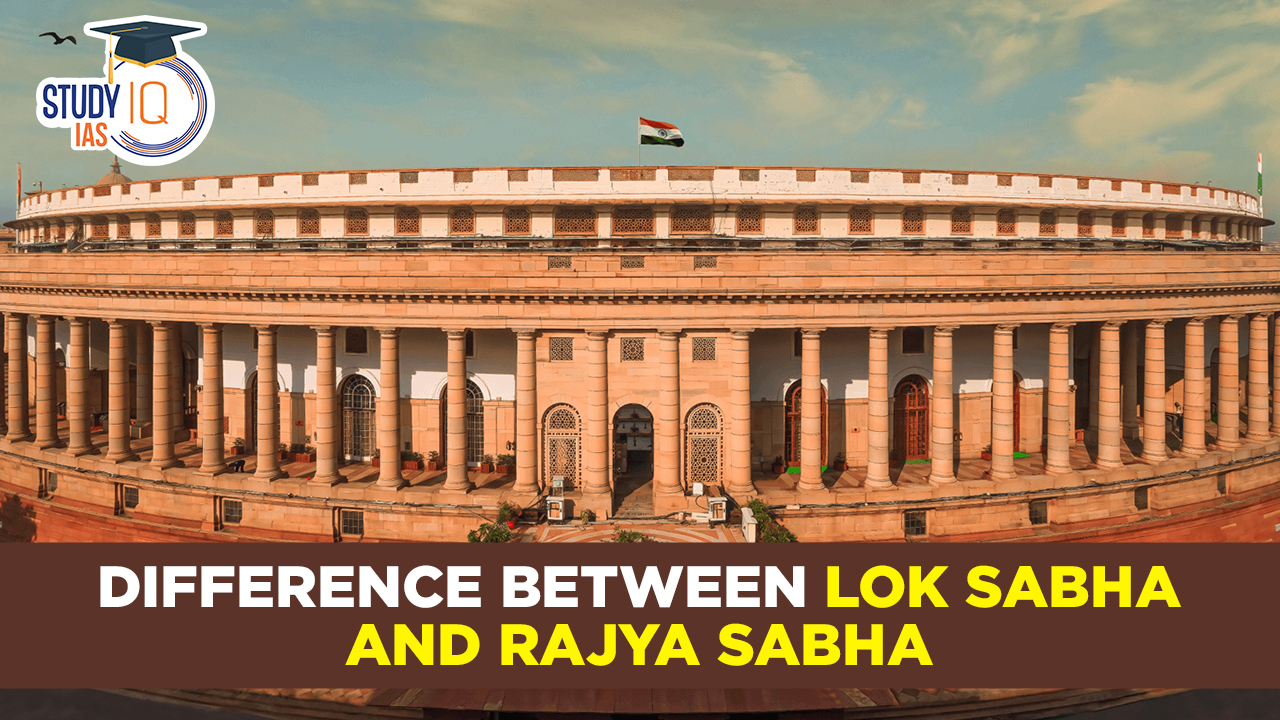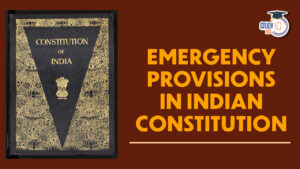Table of Contents
The Indian Parliament is the main legislative body in the country, responsible for making laws, overseeing the government, and representing the people. It consists of two houses: the Lok Sabha (House of the People) and the Rajya Sabha (Council of States). Both houses play important roles in the law-making process.
- The Lok Sabha, or lower house, has members directly elected by the people of India. It drafts and passes laws and is led by the Speaker, elected by its members.
- The Rajya Sabha, or upper house, represents the states and union territories. Its members are elected by the elected members of state legislative assemblies, not directly by the public. The Vice President of India serves as the Chairman.
Difference Between Lok Sabha and Rajya Sabha
Rajya Sabha is the Upper House of Parliament, and Lok Sabha is the Lower House. According to Articles 79–122, the President, Lok Sabha, and Rajya Sabha make up the Indian Parliament. Both the Lok Sabha and the Rajya Sabha are referred to as the House of People. Members of the Lok Sabha are chosen directly through adult suffrage, making it a real reflection of Indian society. The Difference between Lok Sabha and Rajya Sabha is an important part of Indian Polity which an important subject in UPSC Syllabus 2024.
Comparison Between Lok Sabha and Rajya Sabha
India’s Parliament is a bicameral body of government. In 1954, the names “Lok Sabha” and “Rajya Sabha” were introduced in Indian politics. Articles 79 to 122 of the Indian Constitution are covered by the provisions of the Indian Parliament. As examples of how the two houses of parliament differ from one another, consider the following. Below given is the table to show the lok sabha and rajya sabha difference.
| Lok Sabha | Rajya Sabha |
| Directly elected using residents of India | Indirectly elected by using kingdom legislatures |
| Elected through popular elections | Elected through proportional representation through state MLAs |
| Minimum 25 years for eligibility | Minimum 30 years for eligibility |
| Maximum 552 members | Maximum 250 participants |
| Represents the people of India | Represents states and UTs of India |
| 5 years(Note: It can be dissolved earlier by passing a no-confidence motion) | 6 years |
| Speaker elected by members | Vice President of India, who is ex officio Chairman |
| Represents constituencies within states | Represents states as an entire |
| Have limited representation (most 20 individuals) | Have representation (most 2 members) |
| The primary legislative house passes payments and budgets | Represents states’ interests, reviews legislation |
| Can introduce and amend cash bills | Can suggest amendments, but cannot initiate |
| Has very last authority on most payments | Can suggest amendments, can also put off bills |
| Represents people’s pursuits | Represents states’ interests |
Articles related to Lok Sabha and Rajya Sabha
- Article 79: Constitution of Parliament India has a Parliament consisting of the President and two houses: the Lok Sabha (House of the People) and the Rajya Sabha (Council of States).
- Article 80: Composition of the Council of States
- The Rajya Sabha includes:
- 12 members nominated by the President.
- Up to 238 representatives from states and union territories.
- Nominated members should have special knowledge in areas like literature, science, and social service.
- State representatives are elected by state legislative assemblies using a proportional representation system.
- Article 81: Composition of the House of the People
The Lok Sabha has:
- Up to 530 members elected directly from territorial constituencies in the states.
- Up to 20 members representing union territories.
- Seats are allocated based on the population as determined by the last census.
- Article 82: Readjustment after Each Census After each census, the allocation of Lok Sabha seats and state constituencies will be readjusted, but this will not change until the current House is dissolved.
- Article 83: Duration of Houses of Parliament
- The Rajya Sabha is permanent, with one-third of its members retiring every two years.
- The Lok Sabha lasts for five years unless dissolved sooner.
- Article 84: Qualifications for Membership To be eligible for Parliament, a person must:
- Be an Indian citizen and take an oath.
- Be at least 30 years old for the Rajya Sabha and 25 for the Lok Sabha.
- Meet other qualifications set by law.
- Article 85: Sessions of Parliament The President summons each House to meet, ensuring no more than six months pass between sessions.
- Article 86: Right of President to Address Parliament The President can address either House and send messages about pending bills.
- Article 87: Special Address by the President After each general election and at the start of each year, the President addresses both Houses to explain the session’s agenda.
- Article 88: Rights of Ministers and Attorney-General Ministers and the Attorney-General can speak in Parliament and its committees but cannot vote.
Lok Sabha and Rajya Sabha
Ordinary legislation may be introduced and approved by both houses. Each chamber separately must pass a constitutional amendment bill with a special majority. In many ways, the Lok Sabha and Rajya Sabha have equivalent powers and functions. Important Indian legislative bodies with a variety of duties include Lok Sabha and Rajya Sabha. The following are some areas where Rajya Sabha and Lok Sabha have equal authority:
- Bills related to the Consolidated Fund of India.
- Recommending to the President the removal of the Chief Justice, judges of the Supreme Court and high courts, the chief election commissioner, and the CAG.
- Adoption of laws; declaration of an emergency; expansion of the Supreme Court’s and the Union Public Service Commission‘s purview.
Whats is Lok Sabha?
The Lok Sabha, also called the “House of People,” has 543 members directly elected by citizens. These members are important for choosing the Prime Minister, who must have their confidence. Lok Sabha members serve a term of 5 years, after which new elections are held. Unlike the Lok Sabha, Rajya Sabha members can review and change bills passed by the Lok Sabha. However, Lok Sabha members have more power, including the ability to pass a no-confidence motion against the ruling party and dissolve the Assembly.
The Lok Sabha is responsible for introducing and passing important bills related to defense, finance, and home affairs to ensure the government runs smoothly.
Lok Sabha Functions
The Lok Sabha has several duties to carry out, including adopting money bills for financial control and electing its own speaker to run the house’s operations. It also has to pass laws.
- Legislature By moving bills through the house, Lok Sabha has the authority to enact new laws for the country. The Act also repeals and modifies current laws. If a measure is approved by the members of the parliamentary house with a 2/3rd majority, it will become law and be in effect for one year in cases of emergencies or unusual circumstances. According to Article 108 of the Indian Constitution, the President of India may convene a joint session if there is no agreement reached on the most crucial matter among the respective houses. The speaker of the Lok Sabha presides over the combined session of Parliament, and the Lok Sabha acts more powerfully than the Rajya Sabha in terms of legislating the laws.
- Financial Matters The Lok Sabha’s members always take the initiative on money bills. Nearly all measures can be approved by both the Lok Sabha and the Rajya Sabha on an equal basis, but only the Money Bill gives the Lok Sabha the upper hand over the Rajya Sabha. A measure that has been introduced and approved by the Lok Sabha is subsequently referred to the Rajya Sabha for approval and recommendations. The minimum amount of time required for the recommendations to be forwarded from the Rajya Sabha to the Lok Sabha is 14 days. There is no obligation for the Lok Sabha to concur with the Rajya Sabha’s suggestions.
- Elections and Composition The Lok Sabha must consist of no more than 530 members from the territorial constituencies of the States of India and no more than twenty members from the territorial constituencies of Union territories, according to Article 81 of the Indian Constitution. The Speaker of the House of People, who leads the proceedings, is also chosen by the House of People.
- Public Powers The Lok Sabha’s members are normally elected representatives with the authority to debate and discuss various issues of common concern. Discussions in the Parliamentary House may centre on issues like money, government spending, etc. The parliamentary debates and discussions serve as a check on Indian politics.
What is Rajya Sabha?
The Rajya Sabha is the upper house of Parliament and is responsible for state affairs and protecting state rights from the central government. Bills that need to be implemented in the states must be approved by the Rajya Sabha. It has 250 members, and one-third are elected every two years, making it a permanent house. The Vice President is the head of the Rajya Sabha. While it has fewer powers than the Lok Sabha, it still plays an important role in protecting the rights of states and Union Territories.
Rajya Sabha Function
- Legislative Powers The Rajya Sabha has the same authority as the Lok Sabha to pass regular laws (other than money bills). In addition, a bill cannot become law until both Houses have approved it.
- Financial Powers When compared to the Lok Sabha, the Rajya Sabha has less influence over finances. If the Rajya Sabha does not pass a Money Bill within 14 days of receiving it for consideration, the bill is deemed to have been approved by Parliament. Rajya Sabha’s carelessness is irrelevant in this situation. The final decision about whether to accept or reject the proposed amendment rests solely with the Lok Sabha, even if Rajya Sabha delivers the bill to Lok Sabha with certain modifications.
- Executive Powers The Lok Sabha, not the Rajya Sabha, is the Council of Ministers’ collective accountability body, according to Article 75(3) of the Indian Constitution. The Rajya Sabha has some control over the ministers even if it cannot disband the Council of Ministers. It includes critiquing their practises, raising new issues, and introducing adjournment motions. The Rajya Sabha may also provide some of the ministers. Now, the Prime Minister might also originate from the Rajya Sabha if the majority party in the Lok Sabha selects or elects a member as its leader.
Conclusion
The Lok Sabha and Rajya Sabha are both crucial for the country’s smooth operation. Lok Sabha members focus on national and international affairs, passing bills and agreements, while Rajya Sabha members protect state rights by representing them and reviewing Lok Sabha laws. For a country to grow, it is important that both houses work well together, with the Lok Sabha addressing the needs of the Rajya Sabha to find practical solutions for states.
Difference between Lok Sabha and Rajya Sabha UPSC
The main Indian legislative bodies Lok Sabha and Rajya Sabha serve a variety of purposes. For the diverse states and union territories to operate effectively, Lok Sabha and Rajya Sabha are necessary. Bicameralism allows each of the two houses to analyse the other’s decisions, confirm those decisions, and prevent errors. While the Lok Sabha is more powerful because its members are directly elected by the public and are thus seen as the direct representatives of the State, the (Rajya Sabha) Upper House maintains the federal equilibrium by defending the interests of states against excessive interference from the centre. Students can read all the details related to UPSC by visiting the official website of StudyIQ UPSC Online Coaching.


 Indian Secularism: Constitutional Provis...
Indian Secularism: Constitutional Provis...
 India Mediation Campaign, Objectives, Pr...
India Mediation Campaign, Objectives, Pr...
 Emergency Provisions in Indian Constitut...
Emergency Provisions in Indian Constitut...





















